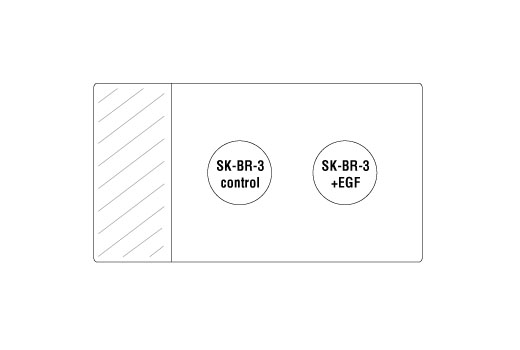| Kit Includes | Quantity | Antigen Retrieval / Diluent | Isotype |
|---|---|---|---|
| Phospho-EGF Receptor (Tyr1068) (D7A5) XP® Rabbit mAb #3777 | 40 µl | EDTA / SignalStain® Antibody Diluent #8112 | Rabbit IgG |
| Phospho-HER2/ErbB2 (Tyr1221/1222) (6B12) Rabbit mAb #2243 | 40 µl | EDTA / SignalStain® Antibody Diluent #8112 | Rabbit IgG |
| Phospho-HER3/ErbB3 (Tyr1289) (D1B5) Rabbit mAb #2842 | 40 µl | EDTA / SignalStain® Antibody Diluent #8112 | Rabbit IgG |
| EGF Receptor (D38B1) XP® Rabbit mAb #4267 | 40 µl | EDTA / SignalStain® Antibody Diluent #8112 | Rabbit IgG |
| *SignalStain® Antibody Diluent #8112 | 25 ml | ||
| †SignalSlide® Phospho-ErbB Family IHC Controls #8117 | 1 Pack |
*SignalStain® Antibody Diluent is supplied as a working solution and should be stored at 4ºC (packaged separately).
†Control slides should be stored at 4ºC (packaged separately).
#P21860, #P00533, #P04626
2065, 1956, 2064
Product Information
Storage
Specificity / Sensitivity
Source / Purification
Monoclonal antibody is produced by immunizing animals with synthetic phosphopeptides corresponding to residues surrounding Tyr1068 of human EGFR, Tyr1221/1222 of human ErbB2, or to Tyr1289 of human HER3/ErbB3. Monoclonal antibody to EGFR is produced by immunizing animals with a synthetic GST-fusion protein corresponding to residues containing the cytoplasmic domain of human EGF receptor.
Product Description
Background
The epidermal growth factor (EGF) receptor is a 170 kDa transmembrane tyrosine kinase that belongs to the HER/ErbB protein family. Ligand binding results in receptor dimerization, autophosphorylation, activation of downstream signaling and lysosomal degradation (1,2). EGFR is phosphorylated on multiple tyrosine residues, each of which leads to activation of a specific downstream pathway. Major residues involved in EGFR signaling include: Tyr845, Tyr992, Tyr1045, Tyr1068, Tyr1148 and Tyr1173 (2-9). Phosphorylation of EGFR at specific serine and threonine residues attenuates EGFR kinase activity. EGFR carboxy-terminal residues Ser1046 and Ser1047 are phosphorylated by CaM kinase II; a mutation to either of these serines results in upregulated EGFR tyrosine autophosphorylation (10).
The ErbB2 (HER2) proto-oncogene encodes a 185 kDa transmembrane, receptor-like glycoprotein with intrinsic tyrosine kinase activity (11). While ErbB2 lacks an identified ligand, ErbB2 kinase activity can be activated in the absence of a ligand when overexpressed and through heteromeric associations with other ErbB family members (12). Amplification of the ErbB2 gene and overexpression of its product are detected in almost 40% of human breast cancers, as such it is a key therapeutic target (13). ErbB2 has several key residues that are phosphorylated upon its activation including Tyr877, Tyr1221/1222 and Tyr1248 (11,14).
HER3/ErbB3 is a member of the ErbB receptor protein tyrosine kinase family, but lacks tyrosine kinase activity. Tyrosine phosphorylation of ErbB3 depends on its association with other ErbB tyrosine kinases. Ligand binding promotes formation of a heterodimer containing ErbB3 and another ErbB protein and subsequent tyrosine phosphorylation of ErbB3 by the activated ErbB kinase (15,16). At least nine putative carboxy-terminal tail tyrosine phosphorylation sites are found in ErbB3, including Tyr1222 and Tyr1289 (17). ErbB3 may function as an oncogenic unit together with other ErbB members in tumor development; ErbB2 requires ErbB3 to drive breast tumor cell proliferation (18). A novel anti-tumor strategy involves inhibiting the interaction between ErbB3 and ErbB tyrosine kinases.
- Hackel, P.O. et al. (1999) Curr Opin Cell Biol 11, 184-9.
- Zwick, E. et al. (1999) Trends Pharmacol Sci 20, 408-12.
- Cooper, J.A. and Howell, B. (1993) Cell 73, 1051-4.
- Hubbard, S.R. et al. Nature 372, 746-54.
- Biscardi, J.S. et al. (1999) J Biol Chem 274, 8335-43.
- Emlet, D.R. et al. (1997) J Biol Chem 272, 4079-86.
- Levkowitz, G. et al. (1999) Mol Cell 4, 1029-40.
- Ettenberg, S.A. et al. (1999) Oncogene 18, 1855-66.
- Rojas, M. et al. (1996) J Biol Chem 271, 27456-61.
- Feinmesser, R.L. et al. (1999) J Biol Chem 274, 16168-73.
- Muthuswamy, S.K. et al. (1999) Mol Cell Biol 19, 6845-57.
- Qian, X. et al. (1994) Proc Natl Acad Sci USA 91, 1500-4.
- Dittadi, R. and Gion, M. (2000) J Natl Cancer Inst 92, 1443-4.
- Kwon, Y.K. et al. (1997) J Neurosci 17, 8293-9.
- Yarden, Y. and Sliwkowski, M.X. (2001) Nat Rev Mol Cell Biol 2, 127-37.
- Guy, P.M. et al. (1994) Proc Natl Acad Sci USA 91, 8132-6.
- Kim, H.H. et al. (1994) J Biol Chem 269, 24747-55.
- Holbro, T. et al. (2003) Proc Natl Acad Sci USA 100, 8933-8.
Species Reactivity
Species reactivity is determined by testing in at least one approved application (e.g., western blot).
Cross-Reactivity Key
H: human M: mouse R: rat Hm: hamster Mk: monkey Vir: virus Mi: mink C: chicken Dm: D. melanogaster X: Xenopus Z: zebrafish B: bovine Dg: dog Pg: pig Sc: S. cerevisiae Ce: C. elegans Hr: horse GP: Guinea Pig Rab: rabbit All: all species expected
Trademarks and Patents
使用に関する制限
法的な権限を与えられたCSTの担当者が署名した書面によって別途明示的に合意された場合を除き、 CST、その関連会社または代理店が提供する製品には以下の条件が適用されます。お客様が定める条件でここに定められた条件に含まれるものを超えるもの、 または、ここに定められた条件と異なるものは、法的な権限を与えられたCSTの担当者が別途書面にて受諾した場合を除き、拒絶され、 いかなる効力も効果も有しません。
研究専用 (For Research Use Only) またはこれに類似する表示がされた製品は、 いかなる目的についても FDA または外国もしくは国内のその他の規制機関により承認、認可または許可を受けていません。 お客様は製品を診断もしくは治療目的で使用してはならず、また、製品に表示された内容に違反する方法で使用してはなりません。 CST が販売または使用許諾する製品は、エンドユーザーであるお客様に対し、使途を研究および開発のみに限定して提供されるものです。 診断、予防もしくは治療目的で製品を使用することまたは製品を再販売 (単独であるか他の製品等の一部であるかを問いません) もしくはその他の商業的利用の目的で購入することについては、CST から別途許諾を得る必要があります。 お客様は以下の事項を遵守しなければなりません。(a) CST の製品 (単独であるか他の資材と一緒であるかを問いません) を販売、使用許諾、貸与、寄付もしくはその他の態様で第三者に譲渡したり使用させたりしてはなりません。また、商用の製品を製造するために CST の製品を使用してはなりません。(b) 複製、改変、リバースエンジニアリング、逆コンパイル、 分解または他の方法により製品の構造または技術を解明しようとしてはなりません。また、 CST の製品またはサービスと競合する製品またはサービスを開発する目的で CST の製品を使用してはなりません。(c) CST の製品の商標、商号、ロゴ、特許または著作権に関する通知または表示を除去したり改変したりしてはなりません。(d) CST の製品をCST 製品販売条件(CST’s Product Terms of Sale) および該当する書面のみに従って使用しなければなりません。(e) CST の製品に関連してお客様が使用する第三者の製品またはサービスに関する使用許諾条件、 サービス提供条件またはこれに類する合意事項を遵守しなければなりません。
